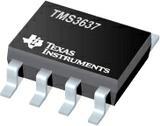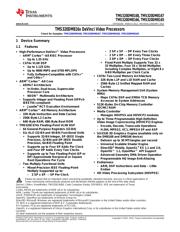herunterladen

TMS320DM8168, TMS320DM8167
TMS320DM8166, TMS320DM8165
www.ti.com
SPRS614D –MARCH 2011–REVISED JANUARY 2013
TMS320DM816x DaVinci Video Processors
Check for Samples: TMS320DM8168, TMS320DM8167, TMS320DM8166, TMS320DM8165
1 Device Summary
1.1 Features
1234567891011
– 2 SP x SP → DP Every Two Clocks
• High-Performance DaVinci™ Video Processors
– 2 SP x DP → DP Every Three Clocks
– ARM
®
Cortex™-A8 RISC Processor
– 2 DP x DP → DP Every Four Clocks
• Up to 1.35 GHz
• Fixed-Point Multiply Supports Two 32 x
– C674x VLIW DSP
32 Multiplies, Four 16 x 16-bit Multiplies
• Up to 1.125 GHz
including Complex Multiplies, or Eight 8 x
• Up to 9000 MIPS and 6750 MFLOPS
8-Bit Multiplies per Clock Cycle
• Fully Software-Compatible with C67x+™
• C674x Two-Level Memory Architecture
and C64x+™
– 32K-Byte L1P and L1D RAM and Cache
• ARM
®
Cortex™-A8 Core
– 256K-Byte L2 Unified Mapped RAM and
– ARMv7 Architecture
Caches
• In-Order, Dual-Issue, Superscalar
• System Memory Management Unit (System
Processor Core
MMU)
• NEON™ Multimedia Architecture
– Maps C674x DSP and EMDA TCB Memory
– Supports Integer and Floating Point (VFPv3-
Accesses to System Addresses
IEEE754 compliant)
• 512K-Bytes On-Chip Memory Controller
• Jazelle
®
RCT Execution Environment
(OCMC) RAM
• ARM
®
Cortex™-A8 Memory Architecture
• Media Controller
– 32K-Byte Instruction and Data Caches
– Manages HDVPSS and HDVICP2 modules
– 256K-Byte L2 Cache
• Up to Three Programmable High-Definition
– 64K-Byte RAM, 48K-Byte Boot ROM
Video Image Coprocessing (HDVICP2) Engines
• TMS320C674x Floating-Point VLIW DSP
– Encode, Decode, Transcode Operations
– 64 General-Purpose Registers (32-Bit)
– H.264, MPEG2, VC1, MPEG4 SP and ASP
– Six ALU (32-Bit and 40-Bit) Functional Units
• SGX530 3D Graphics Engine (available only on
• Supports 32-Bit Integer, SP (IEEE Single
the DM8168 and DM8166 device)
Precision, 32-Bit) and DP (IEEE Double
– Delivers up to 30 MTriangles per second
Precision, 64-Bit) Floating Point
– Universal Scalable Shader Engine
• Supports up to Four SP Adds Per Clock
– Direct3D
®
Mobile, OpenGL
®
ES 1.1 and 2.0,
and Four DP Adds Every Two Clocks
OpenVG™ 1.1, OpenMax™ API Support
• Supports up to Two Floating-Point (SP or
– Advanced Geometry DMA Driven Operation
DP) Approximate Reciprocal or Square
– Programmable HQ Image Anti-Aliasing
Root Operations Per Cycle
• Endianness
– Two Multiply Functional Units
– ARM, DSP Instructions and Data – Little
• Mixed-Precision IEEE Floating-Point
Endian
Multiply Supported up to:
• HD Video Processing Subsystem (HDVPSS)
– 2 SP x SP → SP Per Clock
1
Please be aware that an important notice concerning availability, standard warranty, and use in critical applications of
Texas Instruments semiconductor products and disclaimers thereto appears at the end of this data sheet.
2DaVinci, C64x+, SmartReflex, TMS320C6000, Code Composer Studio, DSP/BIOS, XDS are trademarks of Texas
Instruments.
3Cortex, NEON are trademarks of ARM Ltd or its subsidiaries.
4ARM, Jazelle, Thumb are registered trademarks of ARM Ltd or its subsidiaries.
5USSE, POWERVR are trademarks of Imagination Technologies Limited.
6OpenVG, OpenMax are trademarks of Khronos Group Inc.
7Direct3D, Microsoft, Windows are registered trademarks of Microsoft Corporation in the United States and/or other countries.
8I
2
C BUS is a registered trademark of NXP B.V. Corporation Netherlands.
9PCI Express, PCIe are registered trademarks of PCI-SIG.
10OpenGL is a registered trademark of Silicon Graphics International Corp. or its subsidiaries in the United States and/or other
countries.
11All other trademarks are the property of their respective owners.
PRODUCTION DATA information is current as of publication date. Products conform to
Copyright © 2011–2013, Texas Instruments Incorporated
specifications per the terms of the Texas Instruments standard warranty. Production
processing does not necessarily include testing of all parameters.
Verzeichnis
- ・ Konfiguration des Pinbelegungsdiagramms on Seite 38
- ・ Abmessungen des Paketumrisses on Seite 323 Seite 324
- ・ Markierungsinformationen on Seite 323 Seite 324 Seite 325
- ・ Blockdiagramm on Seite 5 Seite 11 Seite 13 Seite 19 Seite 175
- ・ Typisches Anwendungsschaltbild on Seite 298
- ・ Technische Daten on Seite 136 Seite 153 Seite 174 Seite 179 Seite 180
- ・ Anwendungsbereich on Seite 3 Seite 327
- ・ Elektrische Spezifikation on Seite 121 Seite 139 Seite 140








